|
A look at some of the work that has gone into the depot to prepare it for a museum
SAHC and Village Ink Depot Museum Lease in 2008
by Kevin Maynard
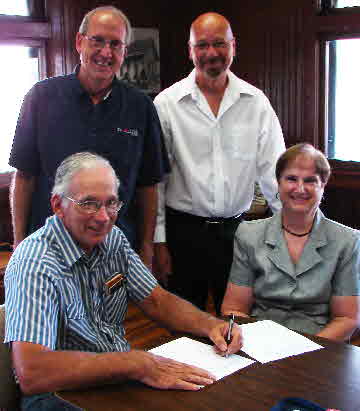
An historic step was taken August 14 when representatives of the Stryker Area Heritage Council and the Village of Stryker executed a lease agreement that will allow the SAHC to develop and operate a museum in Stryker's historic railroad passenger depot.
The lease agreement was signed following unanimous approval by Stryker Village Council on August 11 and the SAHC Board of Trustees August 14.
"This is truly an historic milestone for the SAHC and for the Village," said President Terry Perkins. "Ever since the Stryker Area Heritage Council was created in 2006, it has been our hope to one day establish a museum in the depot. Execution of the lease brings us one step closer to making that dream a reality."
Pictured for the signing ceremony are, (on the left) SAHC Vice President Kent Juillard, seated and Secretary Terry Weiland, standing. On the right are Stryker Village Fiscal Officer Beth Clemens, Seated, and Stryker Village Administrator Gary St. John, standing.
Under the terms of the depot lease, which runs through 2013, the SAHC agrees to develop "a local historical museum that would be of community benefit on many levels." The Heritage Council must insure its personal property, pay for telephone or Internet service if desired, and perform needed building repairs at the Village's expense.
The Village agrees to continue to insure the historic structure, cover utilities costs, and provide mowing and snow removal.
The lease payment is a modest $10 per year. The agreement may be extended for additional two-year terms by mutual agreement of the parties.
A possible leasing arrangement has been under investigation for some time. In July 2007, as part of due diligence efforts, representatives of the SAHC, Village, and Chamber of Commerce visited the Wauseon depot, which has served as a community museum for many years. The final lease document is the result of more than seven months of work on the part of the SAHC and village officials.
The five-year initial lease period provides the SAHC a reasonable opportunity to develop a museum including the purchase or construction of cases and other means to display items, acquisition of appropriate items representing the area's rich heritage, and to develop the necessary volunteer base to staff a museum at regularly scheduled hours and by appointment.
"I want to thank the Village officials and staff, and the SAHC Board of Trustees and members for the vision, leadership, support and cooperation that made this arrangement possible," Perkins added. "Even though we realize there is a tremendous amount of work ahead of us, we are excited about working together to create a community focal point that we can all be proud of."
From SAHC eNews August 2008
Stryker Area Heritage Council members meet with state officials on depot museum May 9, 2009
Two officials of the Ohio Historical Society who provide outreach and historic preservation services around the state met with members of the Stryker Area Heritage Council to discuss how to best develop the depot into a museum.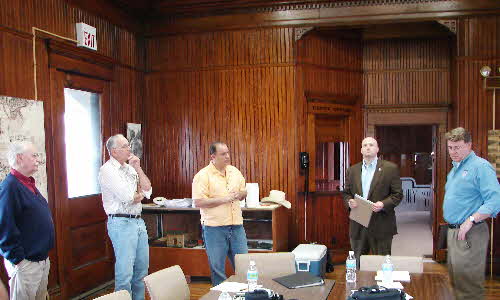
Meeting at the Stryker depot on Saturday (May 9), Jody Blankenship, Manager of Outreach & Field Services for the state historical society, began by congratulating the Stryker area group on the historical programs, publications and website operated by the council. He said the group is doing a fine job of providing education and outreach into the community.
He and Andy Verhoff, Local History Coordinator of the Local History Office of the state society, joined the Stryker heritage council members in a tour of the depot. Both had high praise for the rich wood interior of the building and understood why the community would like to see the structure preserved and used as a museum.
They next began collecting the ideas council members had for activities in the depot. Most of the members said they felt that, due to the size of the depot, they would mostly display items pertaining to Stryker and house the rest in an adjoining room. They expect to change the displays periodically, rotating the items being housed into the displays. Most felt that there would not be enough space to also hold educational sessions or lectures in the depot once the displays are put in.
SAHC Collections Committee Chairman Fred Grisier said he is afraid the council may be deluged with items once they begin accepting them, and could soon run out of space.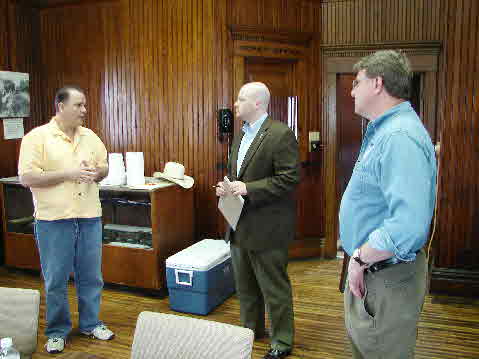
Mr. Blankenship congratulated the members for making considerations about their collections before starting the museum’s development. Too many times, Mr. Blankenship pointed out, groups open their doors and take items without planning as to what they need and how they are going to care for the items once they get them. That can lead to situations where they have so many items that some are never displayed, and that a museum may not end up with items they would like to own or show.
He encouraged the Stryker council members to think about the items or subjects of items they would like to collect. He also suggested the collections policy be expanded to require that the full committee decide on items to be accepted. That would allow the group to be more intentional about the items they receive.
Mr. Verhoff pointed out that once they accept an item, they have it forever. There should be some thought into how the item will be cared for during that time.
“Environment is important,” Mr. Blankenship added. “Variations in temperature and humidity can affect items greatly. They handle things best when those stay at a consistent level.”
Controlling the environment and getting insurance coverage for the building contents are added costs for the council. Mr. Verhoff suggested asking those who donate items to also make a financial contribution to ensure the item or items can be preserved for the years to come.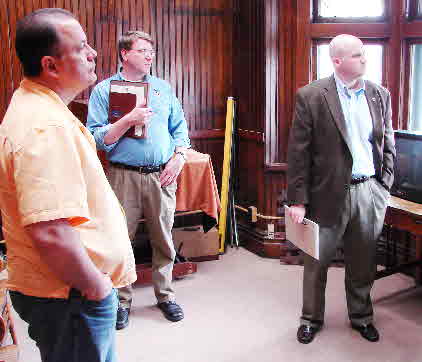
The group touched on how to best exhibit items. While metal shelving with an inert covering is preferred, Blankenship wondered if there were any cabinet makers in the area who might assist the council with their exhibits.
He suggested the council get a computer with software that can catalog their inventory, as well as to keep backup copies off site of the depot.
He also encouraged the council to make plans of what to do with their collection in disaster situations, such as how they might respond if a natural disaster, loss of utilities or water line break might occur.
The subject of volunteers came up. Most agreed that volunteer help would be needed to catalog and display items and to meet with visitors to the museum who would like to know more about the history of the Stryker area.
“This is a big undertaking,” Mr. Blankenship said. “Some groups do this, and their focus turns inward. Everything becomes about the museum.” Several of the Stryker council members said they hoped that the museum would put on special shows and collections from time to time and join in with special promotions in the community, but also felt that the outside programs and lectures should continue to be provided.
The two state officials will take the responses of the council members back with them to their office in Columbus, and provide a plan, auxiliary information and suggestions on how the Stryker heritage council members may proceed with the project.
Photos from a work day on Sept. 5, 2009
Rebecca Miller organized a group of 7 home educated students and another mom to help at the depot work day. Pictured here as they moved a load of donated bricks onto a wagon are, from left to right in the back row, Cody Hankins, Devin Whitlock, Mrs. Carma Hankins and Emily Hankins, on the front is Ezra Miller. Passing the bricks up from the piles on the ground are Stephen Miller, Lydia Hankins and Clarissa Whitlock. Rebecca Miller took the picture.
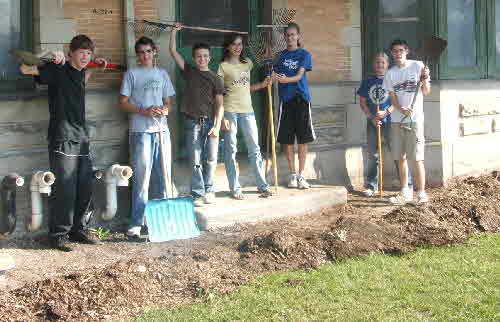
Fun and camaraderie were definitely part of their morning work as this group helped get the Stryker Area Heritage Council workday off to a good start. After re-piling the bricks and digging up all the old mulch for the afternoon “crew” to put in a truck, the group took a moment to pose for posterity. After all they were helping to “make history”.
This shows how the crew of young people in the morning had raked the mulch away from the building, preparing for the afternoon crews.
Jason Baltosser hauled the bricks away from the building once they were loaded on the trailer.
Jason dumps some dirt along the east side of the depot while Sue Buehrer and other crew members wait to smooth it out.
Depot work day April 17, 2010 focused on floor
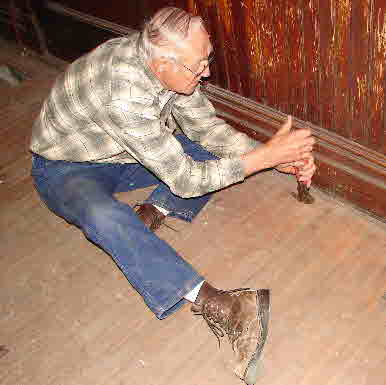 Wooden floors that used to be seen in the Stryker railroad depot are once again making their appearance as a part of the work being done by members of the Stryker Area Heritage Council. Wooden floors that used to be seen in the Stryker railroad depot are once again making their appearance as a part of the work being done by members of the Stryker Area Heritage Council.
The members had a work day on April 17 to work on the floors, part of which had been covered with carpet for years.
Earlier in the week, Phil Short, Erik Short and Kent Juillard helped to pull up the old carpet that covered the large middle room, the west baggage room and the ticket office. The carpet didn’t give much of a struggle coming up according to Kent. The three also pulled up the subfloor underneath the carpet. That also seemed to come up fairly easily, according to Mr. Juillard.
It then turned to the workers to pull up staples sticking up from the floor that had been used to hold the subflooring in place. 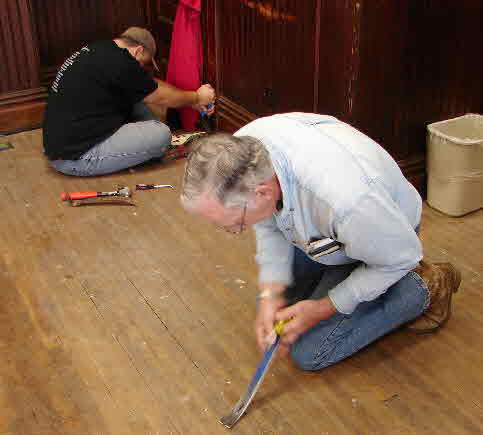
Earlier Phil and Erik had pulled up all of the staples in the ticket office, so the workers focussed their attention on the middle room.
Glen Burkholder is shown in the photo above prying up some staples in a section of the floor on the south side of the middle room.
In the other photo, Kent Juillard (on the right) and Kevin Maynard ply their tools to get the pesky staples out the floor. Bill Priest also provided a hand and Rose Burkholder provided her encouragement, which included some Krispy Kreme donuts she purchased from the Rotary Club (Thanks, Rose!), and by doing some sweeping of the staples that had been pulled from the floor.
By the end of the work day, almost all of the staples were gone from the floor in the middle room. The pile looked like it held several thousand of the little metal hoops.
It won’t take more than a few more minutes to finish up the middle room and then workers can tackle the staples in the floor of the baggage room.
Thanks to everyone who helped (if I missed anyone, please let me know), and look forward to announcements for the next work day!
Floors restored at Stryker Depot in May of 2010
Thanks to the financial help of a local family and the Village of Stryker along with some pieces of wood with local significance, the floors of the Stryker train depot have been restored and are ready for new generations to enjoy the site. The Stryker Area Heritage Council opened the depot during the Stryker Summerfest so people could see how the floors looked.
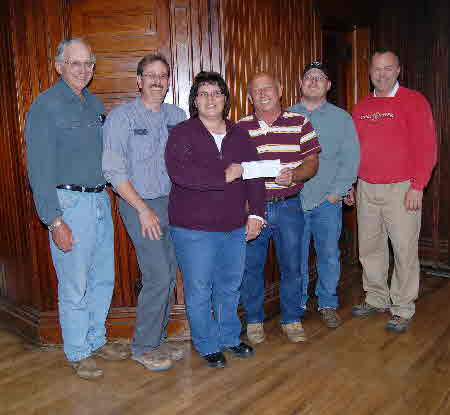 Kirk Eichler (second from left) and his wife, LouAnne Eichler (third from left) are shown presenting a check to help pay for the floor restoration work done recently at the Stryker depot. Pictured from left to right are: Kent Juillard, SAHC Trustee; Kirk Eichler; LouAnne Eichler; Phil Short, SAHC Trustee; Erik Short, SAHC member; and Kenny Imm of Kenny’s Home Specialties, who did the floor restoration work. Kirk Eichler (second from left) and his wife, LouAnne Eichler (third from left) are shown presenting a check to help pay for the floor restoration work done recently at the Stryker depot. Pictured from left to right are: Kent Juillard, SAHC Trustee; Kirk Eichler; LouAnne Eichler; Phil Short, SAHC Trustee; Erik Short, SAHC member; and Kenny Imm of Kenny’s Home Specialties, who did the floor restoration work.
The Stryker Area Heritage Council has been preparing the depot for use as a heritage center ever since they first signed a lease with the Village of Stryker in August of 2008. As the council trustees held their monthly meetings in the building, they noted that the floor on the east side of the depot was made of wood, likely the original flooring. However, the floors on the west side were covered with carpeting that had outlasted its usefulness.
Stryker Area Heritage Council trustee Phil Short, who has been leading the work done on the building with fellow SAHC trustee Kent Juillard and SAHC member Erik Short, said the problem was that no one knew what was under the carpet. He said the trustees hoped that the floor under the carpet was the same original wooden floor, perhaps covered by a protective subflooring cover. They suspected if they removed the carpet, they might be able to find the original flooring, and return the building to the way it looked years ago.
The trustees decided it was worth the try. After pulling up the carpet and the subflooring, Phil, Kent and Erik found that their suspicions were correct. The wooden floor remained just as it had for many years before. It had years of grime and had lost any protective coating it may have once had, but it was still intact. Two additional work days were then held to remove the thousands of staples that had held the subflooring in place.
In the meantime, Kirk and LouAnne Eichler contacted Phil with the offer of a donation to help cover the costs of the restoring the floor to look more like it may have looked early in its history. In making the contribution to the council, Mr. Eichler said, “The donation from the Eichler family is to restore the floors of the depot so we can preserve the heritage of Stryker.”
When Phil and Kent attended a Stryker Village Council meeting to report on the planned restoration, the council pledged to match the donation so the project could be completed. The combination of the two donations now made it possible to not only restore the flooring on the west side of the building, but the east side as well.
The donations also allowed the group to replace some trim around the floor and do some repair work around the registers that completed the floor project.
However, there was one final obstacle. There was also a hole in the flooring of the east side of the building that needed to be repaired, and the group wondered how best to repair it.
SAHC trustee Don Allison had the solution. He offered some floorboards that came from the 1920 Stryker High School study hall floor to fill in the area of the hole. The floorboards ended up being a good match to the depot floor, and the trustees liked the idea that the repair work would be done with boards that also have a historic tie to the community.
Kenny Imm from Kenny’s Home Specialities of Edgerton did the restoration work on the floors, sanding the wood and covering the floor with stain and a couple coats of varnish. With the help of some volunteers, he was able to do the work in two stages, moving all the contents of the building to one side while refinishing the other and then reversing it to complete the other side.
SAHC President Rose Burkholder said the floor restoration is a major step in preparing the depot to become a historic museum for the community. A copy of the museum planning document can be downloaded from the SAHC website.
The council members are pleased to have the work on the floors completed, and opened the doors of the depot after the Stryker Summerfest parade so that anyone interested could see the work that was done.
For more information about the work being done at the depot and for the preservation of history of the Stryker area, check the SAHC website at www.strykerahc.org.
Chimney repair at depot in Nov. of 2010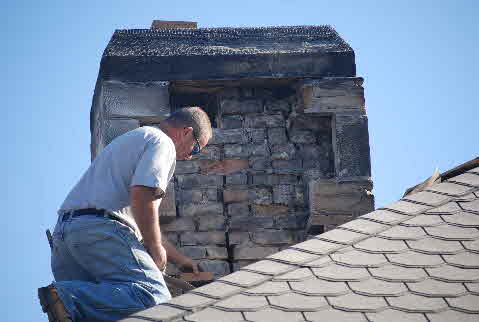
Just before the winter weather set in at the end of last year, work was done to repair the chimney at the depot.
Former SAHC Trustee Phil Short had noticed issues with the chimney and so several area contractors were contacted to find someone to repair it.
Steve Blue of Blue Masonry from rural Hicksville agreed to do the work and you see him here relaying the stone on the outside of the chimney.
He said he could see that the stone had moved at least 2 inches in some places.
When he removed the outside stonework, he discovered an inner lining of old bricks. You can see them in the center of the chimney.
Steve reset the stone and brick in the chimney and touched up the mortar. An aerial lift was provided free of charge by Kyle Sapp of Black Swamp Equipment, Archbold.
Thanks to everyone who helped keep the chimney in the upright position for years to come!
|

